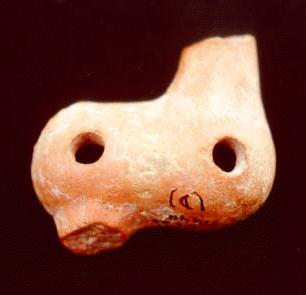
Ocarina Nuiñe
Roberto Velázquez & Gonzalo Sánchez
Virtual Research Institute Tlapitzcalzin & Silbatos Zapotecos.
The ocarina Nuiñe is a Mixtec transverse ocarina that was founded at the Cerro de las Minas, Huajuapan, Oaxaca, Mexico. It has three pitch holes, one is on its button where the mouth is located and the other two are on its top. The shape of the resonator is excellent to produce sounds of high acoustic quality.
The length of the ocarina is 4.7 cm and the diameter of the pitch holes is 0.6 cm.
In the "History of the Ocarina" it is said that it was invented in 1870, at Budrio, Italia, but its design exited in ancient Mexican cultures like the Mixtec, several centuries ago (350-850 a.C.).
Construction procedure
- Photo 1. Mold of two pieces, clay and little sticks.
- Photo 2. The resonating chamber is molded with a finger in the mold.
- Photo 3. The two pieces form the resonating chamber.
- Photo 4. The two pieces are pressed with the hands.
- Photo 5. After several minutes the body is well formed
- Photo 6. The body with the resonating chambers is shaped.
- Photo 7. The flashes are eliminated with a little flattened stick.
- Photo 8. The mouth is made with a little stick in a square shape.
- Photo 9. The edge is sharpened with a round little stick.
- Photo 10. The embouchure is molded with a flattened piece of clay around a little stick and it is located in front of the edge.
- Photo 11. The embouchure is patched with little pices of clay.
- Photo 12. The head of a bird is modeled. It is used to sustein the whisctle with two fingers and the thee pitch holes are drilled with a little round stick.
- Photo 13. The finished ocarina, before drying and burning.
- Photo 14. The whistle is painted and dried.
- Photo 15 Ocarinas after their burning.

